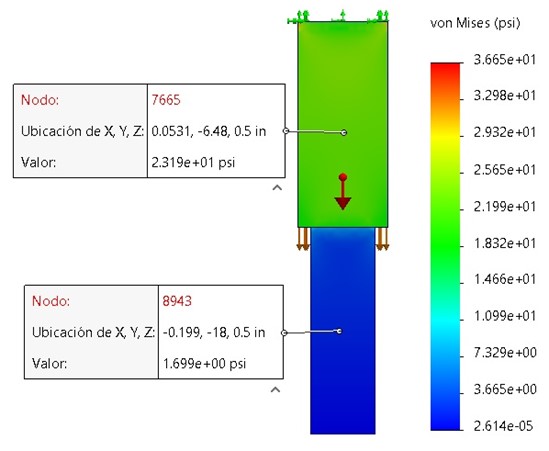Simulación de esfuerzos mecánicos en materiales para la ingeniería
DOI:
https://doi.org/10.36790/epistemus.v18i36.314Palabras clave:
SolidWorks,, Esfuerzo,, Esfuerzo mecánicoResumen
El trabajo desarrollado en este artículo corresponde en enseñar a los estudiantes de ingeniería como a través del uso de una simulación con el software SolidWorks® es posible obtener los mismos resultados al hacer un análisis matemático de los esfuerzos mecánicos en materiales. El artículo explica una serie de pasos a seguir en dicho software para obtener los resultados del análisis de esfuerzos. Primero, se explica de forma breve el análisis matemático en un tipo de material (dos placas de metal). Después se obtienen los mismos resultados utilizando el software, ya que solo con entender los conceptos fundamentales de esfuerzos, el estudiante será capaz de comprender y predecir los resultados que arroja el SolidWorks® sin estudiar a fondo las matemáticas que conlleva dicho análisis en el material.
Descargas
Citas
(2010). Mecánica de materiales (No. TA405. B43 1994.). Mc Graw Hill.
Hancock, J. W., & Mackenzie, A. C. (1976). On the mechanisms of ductile failure in high-strength steels subjected to multi-axial stress-states. Journal of the Mechanics and Physics of Solids, 24(2-3), 147-160. DOI: https://doi.org/10.1016/0022-5096(76)90024-7 DOI: https://doi.org/10.1016/0022-5096(76)90024-7
Salehinia, I., Shao, S., Wang, J., & Zbib, H. M. (2014). Plastic deformation of metal/ceramic nanolayered composites. Jom, 66, 2078-2085. DOI: https://doi.org/10.1007/s11837-014-1132-7 DOI: https://doi.org/10.1007/s11837-014-1132-7
Karuppasamy, K. S. K., Balaji, P. S., & Sahoo, N. (2020). Introduction to Stress-Strain Relationship and Its Measurement Techniques. In Applications and Techniques for Experimental Stress Analysis (pp. 22-38). IGI Global. DOI: 10.4018/978-1-7998-1690-4.ch002 DOI: https://doi.org/10.4018/978-1-7998-1690-4.ch002
Tu, S., Ren, X., He, J., & Zhang, Z. (2020). Stress–strain curves of metallic materials and post‐necking strain hardening characterization: A review. Fatigue & Fracture of Engineering Materials & Structures, 43(1), 3-19. DOI: https://doi.org/10.1111/ffe.13134 DOI: https://doi.org/10.1111/ffe.13134
Nemati, K. M., Monteiro, P. J., & Scrivener, K. L. (1998). Analysis of compressive stress-induced cracks in concrete. ACI Materials Journal, 95, 617-630. DOI: https://doi.org/10.14359/404
Nakamitsu, M., Oyama, K., Imai, H., Fujii, S., & Oaki, Y. (2021). Ultrahigh‐sensitive compression‐stress sensor using integrated stimuli‐responsive materials. Advanced Materials, 33(14), 2008755. DOI: https://doi.org/10.1002/adma.202008755 DOI: https://doi.org/10.1002/adma.202008755
Naughton, J. W., & Sheplak, M. (2002). Modern developments in shear-stress measurement. Progress in Aerospace Sciences, 38(6-7), 515-570. DOI: https://doi.org/10.1016/S0376-0421(02)00031-3 DOI: https://doi.org/10.1016/S0376-0421(02)00031-3
Fu, P., & Dafalias, Y. F. (2011). Study of anisotropic shear strength of granular materials using DEM simulation. International Journal for Numerical and Analytical Methods in Geomechanics, 35(10), 1098-1126. DOI: https://doi.org/10.1002/nag.945 DOI: https://doi.org/10.1002/nag.945
Towle, L. C., & Riecker, R. E. (1968). Empirical relationship between shear strength, pressure, and temperature-II. Applied Physics Letters, 13(5), 159-161. DOI: https://doi.org/10.1063/1.1754828 DOI: https://doi.org/10.1063/1.1652552
Varghese, T., Ophir, J., & Krouskop, T. A. (2000). Nonlinear stress-strain relationships in tissue and their effect on the contrast-to-noise ratio in elastograms. Ultrasound in medicine & biology, 26(5), 839-851. DOI: https://doi.org/10.1016/S0301-5629(00)00199-X DOI: https://doi.org/10.1016/S0301-5629(00)00199-X
Amijima, S., & Adachi, T. (1979). Nonlinear stress-strain response of laminated composites. Journal of composite materials, 13(3), 206-218. DOI: https://doi.org/10.1177/0021998379013003 DOI: https://doi.org/10.1177/002199837901300303
Rossini, N. S., Dassisti, M., Benyounis, K. Y., & Olabi, A. G. (2012). Methods of measuring residual stresses in components. Materials & Design, 35, 572-588. DOI: https://doi.org/10.1016/j.matdes.2011.08.022 DOI: https://doi.org/10.1016/j.matdes.2011.08.022
Parlevliet, P. P., Bersee, H. E., & Beukers, A. (2007). Residual stresses in thermoplastic composites—A study of the literature—Part I: Formation of residual stresses. Composites Part A: Applied Science and Manufacturing, 37(11), 1847-1857. DOI: https://doi.org/10.1016/j.compositesa.2006.12.005 DOI: https://doi.org/10.1016/j.compositesa.2005.12.025
Suárez, J. C., Remartınez, B., Menéndez, J. M., Güemes, A., & Molleda, F. (2003). Optical fibre sensors for monitoring of welding residual stresses. Journal of materials processing technology, 143, 316-320. DOI: https://doi.org/10.1016/S0924-0136(03)00481-3 DOI: https://doi.org/10.1016/S0924-0136(03)00481-3
Sanderson, R. M., & Shen, Y. C. (2010). Measurement of residual stress using laser-generated ultrasound. International journal of pressure vessels and piping, 87(12), 762-765. DOI: https://doi.org/10.1016/j.ijpvp.2010.10.001 DOI: https://doi.org/10.1016/j.ijpvp.2010.10.001
Guo, L. C., & Noda, N. (2010). An analytical method for thermal stresses of a functionally graded material cylindrical shell under a thermal shock. Acta Mechanica, 214(1-2), 71-78. DOI: https://doi.org/10.1007/s00707-010-0315-8 DOI: https://doi.org/10.1007/s00707-010-0315-8
Reddy, J. N., & Chin, C. D. (1998). Thermomechanical analysis of functionally graded cylinders and plates. Journal of thermal Stresses, 21(6), 593-626. DOI: https://doi.org/10.1080/01495739808956165 DOI: https://doi.org/10.1080/01495739808956165
Lisiak-Myszke, M., Marciniak, D., Bieliński, M., Sobczak, H., Garbacewicz, Ł., & Drogoszewska, B. (2020). Application of finite element analysis in oral and maxillofacial surgery—A literature review. Materials, 13(14), 3063. DOI: https://doi.org/10.3390/ma13143063 DOI: https://doi.org/10.3390/ma13143063
Chandrupatla, T. (2004). Finite Element Analysis for Engineering & Tech. Universities Press.

Publicado
Cómo citar
Número
Sección
Licencia
Derechos de autor 2024 EPISTEMUS

Esta obra está bajo una licencia internacional Creative Commons Atribución-NoComercial-CompartirIgual 4.0.
La revista adquiere los derechos patrimoniales de los artículos sólo para difusión sin ningún fin de lucro, sin menoscabo de los propios derechos de autoría.
Los autores son los legítimos titulares de los derechos de propiedad intelectual de sus respectivos artículos, y en tal calidad, al enviar sus textos expresan su deseo de colaborar con la Revista Epistemus, editada semestralmente por la Universidad de Sonora.
Por lo anterior, de manera libre, voluntaria y a título gratuito, una vez aceptado el artículo para su publicación, ceden sus derechos a la Universidad de Sonora para que la Universidad de Sonora edite, publique, distribuya y ponga a disposición a través de intranets, internet o CD dicha obra, sin limitación alguna de forma o tiempo, siempre y cuando sea sin fines de lucro y con la obligación expresa de respetar y mencionar el crédito que corresponde a los autores en cualquier utilización que se haga del mismo.
Queda entendido que esta autorización no es una cesión o transmisión de alguno de sus derechos patrimoniales en favor de la mencionada institución. La UniSon le garantiza el derecho de reproducir la contribución por cualquier medio en el cual usted sea el autor, sujeto a que se otorgue el crédito correspondiente a la publicación original de la contribución en Epistemus.
Salvo indicación contraria, todos los contenidos de la edición electrónica se distribuyen bajo una licencia de uso y Attribution-NonCommercial-ShareAlike 4.0 International (CC BY-NC-SA 4.0) Puede consultar desde aquí la versión informativa y el texto legal de la licencia. Esta circunstancia ha de hacerse constar expresamente de esta forma cuando sea necesario.















